Globe-trotting Gujaratis zoom in on Alappuzha to revive their lost glory and rechristen their heritage town (Text and pictures by Kurian Pampadi)
Published on 18 November, 2017

Over a hundred Gujaratis, mostly from Mumbai, recently descended on Alappuzha on the west coast of the State of Kerala in South India, intent on reviving the lost glory of the town where they were born but left for pastures new during their mid-life crisis. They were responding to a fervent call of the Stare's Finance Minister Thomas Isaac who underwrote their travelling and boarding expenses to be part of a unique idea.
As everyone knows, the Gujaratis are the most peripatetic community in India who have made it big in every field they tread on. They almost control the economy of many African nations. United Kingdom has 600,000 of them. More than 100,000 Gujaratis live in New York City alone. They are in business, administration, academics and politics. The second largest Gujarati diaspora live in Pakistan. The Gujaratis landed in Alappuzha well after the Arabs, the Chinese, the Duch and the Portuguese arrived in the Malabar coast but before the English.
"This is going to be the third birth of the town of Alleppey, as it was called during the colonial days", said Isaac, who represents Alappuzha constituency, in his presidential address, in the precincts the 154-year old school, the Gujarati Hitwardhak Vidyasala, on the Gujarati Street across the arterial Commercial Canal. The town was originally conceived by Raja Kesavdas, the Diwan of the Kingdom of Travancore during the reign of Dharma Raja Karthika Thirunal Rama Varma in the 18th century.
In order to develop Alappuzha into a port, the Diwan built two parallel canals to bring in merchant vessels into the heart of the town. The port was thrown open in 1762 and merchants from Gujarat were invited to make use of the facilities for the export of coconut oil, coir and coir products and spices. Gujarati communities namely the Parsies, Jains, Vaishnavites and Kuchi Memons joined the chorus of merchants visiting and settling down and building their warehouses.
Development into a flourishing port with criss-crossing canals earned the town the nick-name 'Venice of the East'. The glorious days of trade denotes the second birth of the town, says, Thomas Isaac. European companies like Daras Mail and Aspinwall led the growth of the port town as most prosperous centre of Indo-European trade. Cardamom known as 'Alleppey Green' tickled taste buds from England to Spain, Portugal and Italy. Just as town planning was first introduced in Alappuzha, the first post office in Kerala was established in the town in 1857.
But as Cochin was developed into a natural port, there was a shift of attention from Alappuzha. Traders and businessmen began leaving lock stock and barrel. As per 2011 census Aalappuzha municipality has an area of 46.77 square kilometers with a population of 1, 77,079. women edging out men marginally. The town is 100 percent literate. However, the original settlements of Gujarati, Parsi and Kutchi Memon remain a specter of its own glory. The 175 m-long Gujarati Street built around Kerala's oldest Jain temple remains almost empty of original owners. The Gujarati Street Residents Association has 85 members presided over by a Malayali writer Martin Eresseril There are only 15 Gujarati families as members. But there are very many Gujarati houses and havelis left to the elements or rented out or kept under lock and key for the owners' blue moon homecoming.
"This is where we start rebuilding. We want to revive the town to its old glory. This will be its third birth," declares an enthusiastic Thomas Isaac in his address to the conclave opened by Tourism Minister Kadakampally Surendran. Conservation of the old buildings will be primary concern of the Alappuzha Heritage Project. Building a Mahatma Gandhi Museum will be next. Memory Lane Walk will form the third component. Finding that Alappuzha is more akin to the Dutch city of Leiden, the authorities have invited a team from Netherlands to visit the city to help out.
Dr. Benny Kuriakose, Conservation Architect of Kochi Muziris Project fame, made an appealing presentation of the Heritage Project. explaining its various phases and time schedules. In one year the first phase of the project will be ready top open. Panel discussions followed on Day One and Day Two. A 12-point memorandum presented by Martin Eresseril, president and Jojo Mathew, Secretary of the Gujarati Street Residents Association(GSRA), won all round praise. It proposed the creation of a Gujatati Village modeled on the Global Village in Dubai and in Tokyo, possibly in the defunct Gujarati School.
Eresseril and his wife Grace pride themselves that the house they acquired ten years back, was originally constructed in 1926 by Khatavu Khimji, a Porbandar-born buisnessman. When Gandhiji visited Alappuzha in 1927, he initiated a few dozens of toddlers to letters and the venue was the new Khatavu home. Martin was told that Gandhiji also stayed in the house. As a proud inheritor, he restored the ornate building to its original splendour with period chandeliers and wall clocks.
Caught between the discussions, Bhavesh Erda, Joint Secretary, Cultural Activities, Government of Gujarat, told Dr. Bina Thomas Tharakan, an archeologist and heritage consultant born and brought up in Baroda, that his Government was keen in extending any support for the rejuvenation of Gujarati-Kerala ties under the Heritage Project. Extending the theme, Vishnu Pandya , President of the Gujarat Sahithya Academy, extolled the state's historical links with Adi Shankara of Kerala.
On the front row was Deepak P. Gevaria, a chartered accountant from Bapubhai Vashi Road in Ville Parle, Mumbai. He said he came to Alappuzha because his wife Bhavana was born in the town. "I am retiring from D.P. Ghevaria and Co, Chartered Accountants, Perin Nariman Street, in a few months. God help, I might decide to come and settle in Alappuzha for the rest of our lives," he said. Bhavana was looking forward to the day.
Arun Sampat, owner of the Mathuradas Dharamsey Bhavan, West of Tripple Bridge, where the office of the Alappuzha Heritage Project functions, was all smiles to chip in. Born in Alappuzha, he left for Mumbai long back but decided to stage a come back to do his mite for the town's revival idea. He has formed a Kerala Gujarati Forum in Mumbai under whose auspices some 75 ex-Kerala Gujaratis arrived in Alappuzha by Nethravati Express.
"But for the trade unionism, I would have remained in Alappuzha," confided Vijay Sharma who moved with family to Kangayam to set up Copra and Coconut oil business in Coimbatore. He sources coconut oil from Kerala and exports it by tanker lorries to upcountry destinations. One tanker can carry 20,000 kg of oil costing around Rs.22 lakhs earning him a net profit of Rs 20,000. "I have seen never ending streams of workers coming out of the Aspilwall coir factory gates when the siren blares. But the company folded due to never-ending strikes." he said. And yet he loves Alappuzha, marries off his daughters here and admits them to Kerala hospitals to deliver."
During lunch break, it was for Rasheed, his long time friend in the town, to fetch him plate of Gujarati thali comprising Roti, Bhakri, Chaval, Dhal, Khadi, Khaman Dhokla, Sreekant and Jalebi. Rasheed, who was with the Kerala House in Delhi, returned to join his parent Local Self Government office recently. Ten years back he invested in a 125-year old heritage building facing the Commercial Canal owned by a third generation Gujarati Navinchand Uttar Ram. He and his wife Rajeena hopes to open a Homestay well before he retires in two years. The sumptuous lunch for the Gujarati get-together was provided by fourth generation Gujaratis, Amit and Minal The young couple also run a successful 20-cab enterprises, AB Cabs, near Bazar in the town.
Bridget Jose, vice president of the GSRA rushed in to chat with her long lost Gujarati friends. A retired teacher, she was in a hurry as she was about to leave for Melbourne to join her daughter Meera for a while. Just opposite to the Gujarati School, I met a retired professor couple, John K. Thayil and Baby Punnooran. Next to them was Nandakumar and Shanthi at their corner home Aiswarya. As an employee of the Cyodia Corporation of Japan, Nandakumar retuned home after being part of a CNG project in Sakhalin Island off Vladivostok in Russia and later in Papua New Guinea.
The Cutchi Memons and Halai Memons in Alappuzha, numbering around 100, live in the Zakkaia Bazar, Civil Station and Palace wards of the municipality. Halai Memons are known for the 250-year old iconic Shaukar Mosque and the Halais Restaurant being run by Hamdulla Haneef Sait near the South Poice Station where they serve excellent biriyanis.
Haji Haroon Tayub was the head of the first Cutchi Memon family invited by Diwan Raja Kesavadas to Alappuzha. His son Haji Mohamed Jaffar Sait became the chairman of the Alappuzha Municipal Council and later his br-in-law A.R. Sulaiman Sait also served as chairman. Abdul Rahman Sait, president of the present Cutchi Memon Jamath and Mohamed Yusaf Sait, General Secretary of the Halai Memon Community also participated in the deliberations.
Tourism Secretary Dr. V.Venu, fresh from London where he received World Tourism Organisations's Responsible Tourism Awards for Kerala, spoke passionately about the Heritage Project. His speech in fluent Hindi was widely applauded. Alappuzha's revered historian Kalleli Raghavan Pillai. four months away from his 90th birthday, was introduced to the audience by the Minister himself. Kalleli was full of enthusiasm and excitement. Thereafter, P. Jyothis, his old student at the SDV High School, met him to offer advanced birthday greetings.
Come 2020, you will see a verdant canal city born again in its splendorous best. The first phase will be ready in an year. Mentor and Minister T.M.Thomas Isaac is positive that it would be the first attempt in India to recreate past and set it against the present and the future.
As everyone knows, the Gujaratis are the most peripatetic community in India who have made it big in every field they tread on. They almost control the economy of many African nations. United Kingdom has 600,000 of them. More than 100,000 Gujaratis live in New York City alone. They are in business, administration, academics and politics. The second largest Gujarati diaspora live in Pakistan. The Gujaratis landed in Alappuzha well after the Arabs, the Chinese, the Duch and the Portuguese arrived in the Malabar coast but before the English.
"This is going to be the third birth of the town of Alleppey, as it was called during the colonial days", said Isaac, who represents Alappuzha constituency, in his presidential address, in the precincts the 154-year old school, the Gujarati Hitwardhak Vidyasala, on the Gujarati Street across the arterial Commercial Canal. The town was originally conceived by Raja Kesavdas, the Diwan of the Kingdom of Travancore during the reign of Dharma Raja Karthika Thirunal Rama Varma in the 18th century.
In order to develop Alappuzha into a port, the Diwan built two parallel canals to bring in merchant vessels into the heart of the town. The port was thrown open in 1762 and merchants from Gujarat were invited to make use of the facilities for the export of coconut oil, coir and coir products and spices. Gujarati communities namely the Parsies, Jains, Vaishnavites and Kuchi Memons joined the chorus of merchants visiting and settling down and building their warehouses.
Development into a flourishing port with criss-crossing canals earned the town the nick-name 'Venice of the East'. The glorious days of trade denotes the second birth of the town, says, Thomas Isaac. European companies like Daras Mail and Aspinwall led the growth of the port town as most prosperous centre of Indo-European trade. Cardamom known as 'Alleppey Green' tickled taste buds from England to Spain, Portugal and Italy. Just as town planning was first introduced in Alappuzha, the first post office in Kerala was established in the town in 1857.
But as Cochin was developed into a natural port, there was a shift of attention from Alappuzha. Traders and businessmen began leaving lock stock and barrel. As per 2011 census Aalappuzha municipality has an area of 46.77 square kilometers with a population of 1, 77,079. women edging out men marginally. The town is 100 percent literate. However, the original settlements of Gujarati, Parsi and Kutchi Memon remain a specter of its own glory. The 175 m-long Gujarati Street built around Kerala's oldest Jain temple remains almost empty of original owners. The Gujarati Street Residents Association has 85 members presided over by a Malayali writer Martin Eresseril There are only 15 Gujarati families as members. But there are very many Gujarati houses and havelis left to the elements or rented out or kept under lock and key for the owners' blue moon homecoming.
"This is where we start rebuilding. We want to revive the town to its old glory. This will be its third birth," declares an enthusiastic Thomas Isaac in his address to the conclave opened by Tourism Minister Kadakampally Surendran. Conservation of the old buildings will be primary concern of the Alappuzha Heritage Project. Building a Mahatma Gandhi Museum will be next. Memory Lane Walk will form the third component. Finding that Alappuzha is more akin to the Dutch city of Leiden, the authorities have invited a team from Netherlands to visit the city to help out.
Dr. Benny Kuriakose, Conservation Architect of Kochi Muziris Project fame, made an appealing presentation of the Heritage Project. explaining its various phases and time schedules. In one year the first phase of the project will be ready top open. Panel discussions followed on Day One and Day Two. A 12-point memorandum presented by Martin Eresseril, president and Jojo Mathew, Secretary of the Gujarati Street Residents Association(GSRA), won all round praise. It proposed the creation of a Gujatati Village modeled on the Global Village in Dubai and in Tokyo, possibly in the defunct Gujarati School.
Eresseril and his wife Grace pride themselves that the house they acquired ten years back, was originally constructed in 1926 by Khatavu Khimji, a Porbandar-born buisnessman. When Gandhiji visited Alappuzha in 1927, he initiated a few dozens of toddlers to letters and the venue was the new Khatavu home. Martin was told that Gandhiji also stayed in the house. As a proud inheritor, he restored the ornate building to its original splendour with period chandeliers and wall clocks.
Caught between the discussions, Bhavesh Erda, Joint Secretary, Cultural Activities, Government of Gujarat, told Dr. Bina Thomas Tharakan, an archeologist and heritage consultant born and brought up in Baroda, that his Government was keen in extending any support for the rejuvenation of Gujarati-Kerala ties under the Heritage Project. Extending the theme, Vishnu Pandya , President of the Gujarat Sahithya Academy, extolled the state's historical links with Adi Shankara of Kerala.
On the front row was Deepak P. Gevaria, a chartered accountant from Bapubhai Vashi Road in Ville Parle, Mumbai. He said he came to Alappuzha because his wife Bhavana was born in the town. "I am retiring from D.P. Ghevaria and Co, Chartered Accountants, Perin Nariman Street, in a few months. God help, I might decide to come and settle in Alappuzha for the rest of our lives," he said. Bhavana was looking forward to the day.
Arun Sampat, owner of the Mathuradas Dharamsey Bhavan, West of Tripple Bridge, where the office of the Alappuzha Heritage Project functions, was all smiles to chip in. Born in Alappuzha, he left for Mumbai long back but decided to stage a come back to do his mite for the town's revival idea. He has formed a Kerala Gujarati Forum in Mumbai under whose auspices some 75 ex-Kerala Gujaratis arrived in Alappuzha by Nethravati Express.
"But for the trade unionism, I would have remained in Alappuzha," confided Vijay Sharma who moved with family to Kangayam to set up Copra and Coconut oil business in Coimbatore. He sources coconut oil from Kerala and exports it by tanker lorries to upcountry destinations. One tanker can carry 20,000 kg of oil costing around Rs.22 lakhs earning him a net profit of Rs 20,000. "I have seen never ending streams of workers coming out of the Aspilwall coir factory gates when the siren blares. But the company folded due to never-ending strikes." he said. And yet he loves Alappuzha, marries off his daughters here and admits them to Kerala hospitals to deliver."
During lunch break, it was for Rasheed, his long time friend in the town, to fetch him plate of Gujarati thali comprising Roti, Bhakri, Chaval, Dhal, Khadi, Khaman Dhokla, Sreekant and Jalebi. Rasheed, who was with the Kerala House in Delhi, returned to join his parent Local Self Government office recently. Ten years back he invested in a 125-year old heritage building facing the Commercial Canal owned by a third generation Gujarati Navinchand Uttar Ram. He and his wife Rajeena hopes to open a Homestay well before he retires in two years. The sumptuous lunch for the Gujarati get-together was provided by fourth generation Gujaratis, Amit and Minal The young couple also run a successful 20-cab enterprises, AB Cabs, near Bazar in the town.
Bridget Jose, vice president of the GSRA rushed in to chat with her long lost Gujarati friends. A retired teacher, she was in a hurry as she was about to leave for Melbourne to join her daughter Meera for a while. Just opposite to the Gujarati School, I met a retired professor couple, John K. Thayil and Baby Punnooran. Next to them was Nandakumar and Shanthi at their corner home Aiswarya. As an employee of the Cyodia Corporation of Japan, Nandakumar retuned home after being part of a CNG project in Sakhalin Island off Vladivostok in Russia and later in Papua New Guinea.
The Cutchi Memons and Halai Memons in Alappuzha, numbering around 100, live in the Zakkaia Bazar, Civil Station and Palace wards of the municipality. Halai Memons are known for the 250-year old iconic Shaukar Mosque and the Halais Restaurant being run by Hamdulla Haneef Sait near the South Poice Station where they serve excellent biriyanis.
Haji Haroon Tayub was the head of the first Cutchi Memon family invited by Diwan Raja Kesavadas to Alappuzha. His son Haji Mohamed Jaffar Sait became the chairman of the Alappuzha Municipal Council and later his br-in-law A.R. Sulaiman Sait also served as chairman. Abdul Rahman Sait, president of the present Cutchi Memon Jamath and Mohamed Yusaf Sait, General Secretary of the Halai Memon Community also participated in the deliberations.
Tourism Secretary Dr. V.Venu, fresh from London where he received World Tourism Organisations's Responsible Tourism Awards for Kerala, spoke passionately about the Heritage Project. His speech in fluent Hindi was widely applauded. Alappuzha's revered historian Kalleli Raghavan Pillai. four months away from his 90th birthday, was introduced to the audience by the Minister himself. Kalleli was full of enthusiasm and excitement. Thereafter, P. Jyothis, his old student at the SDV High School, met him to offer advanced birthday greetings.
Come 2020, you will see a verdant canal city born again in its splendorous best. The first phase will be ready in an year. Mentor and Minister T.M.Thomas Isaac is positive that it would be the first attempt in India to recreate past and set it against the present and the future.
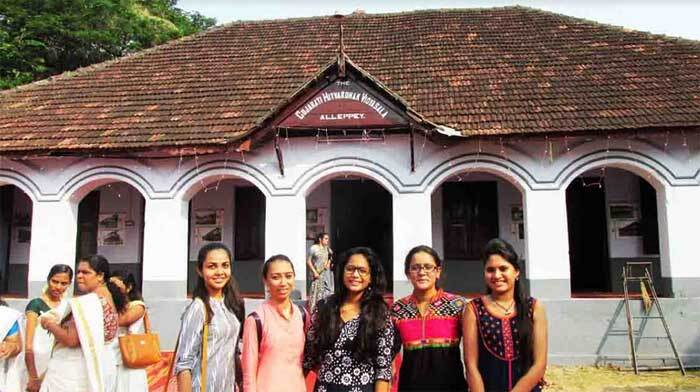
Young Gujaratis pose in front of the 154-year old Gujarati School in Alappuzha
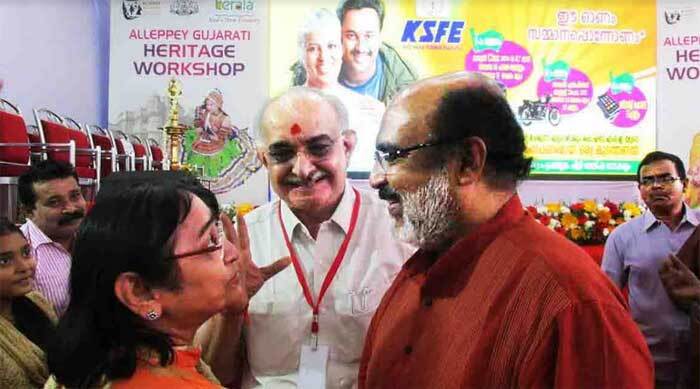
Minister Thomas Isaac interacts with Arun Sampat and his friend from Mumbai.

Ex-Alappuzha ladies from Mumbai.
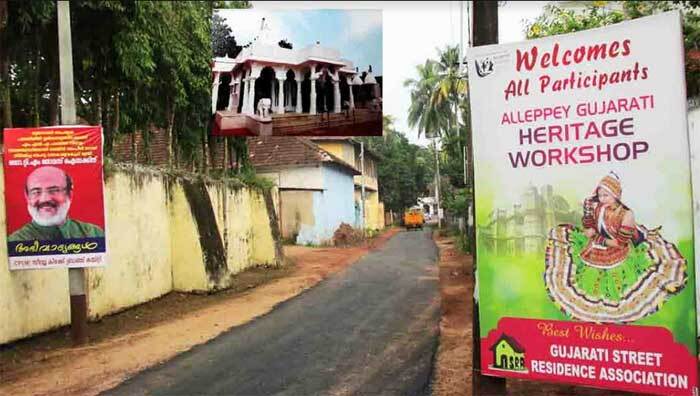
Welcome by Gujarati Street Residents Association. Jain temple inset.
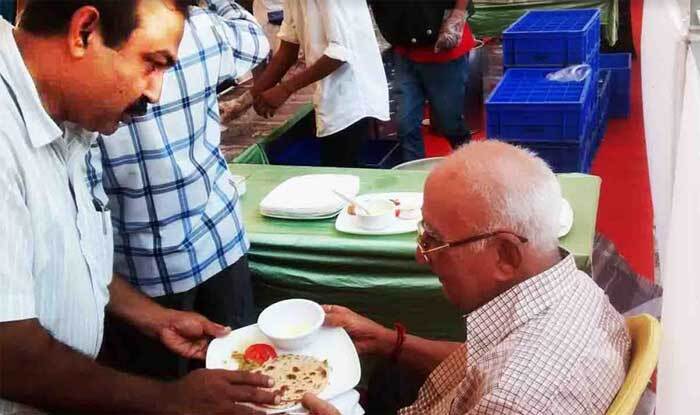
Rasheed serves a Gujarati thali to his old neighbour Vijaya Sharma
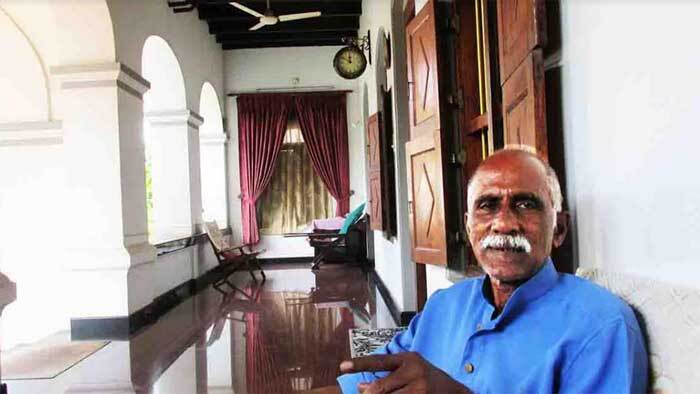
Martin Eresseril in his heritage home that hosted Gandhiji in 1927.
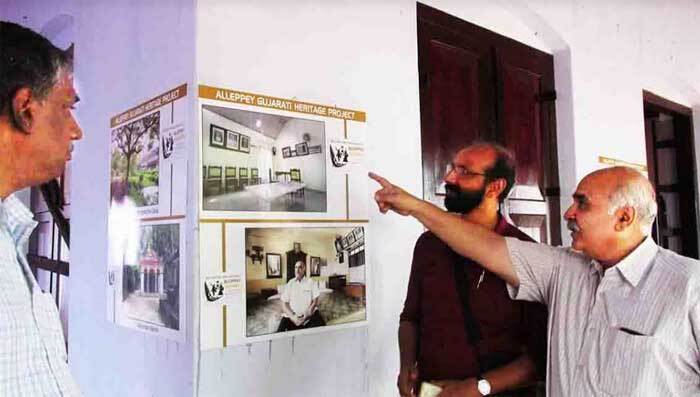
Ramakrishna Khandelwal looks at his own picture on display. Flanked by George K. John of Anert and R. Ajith, aide to Minister.
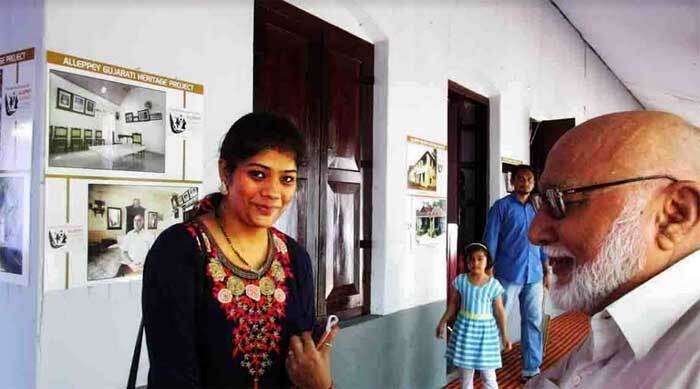
Hostess Minal Amit greets Halai Memon Community leader Mohamed Yusaf Sait.
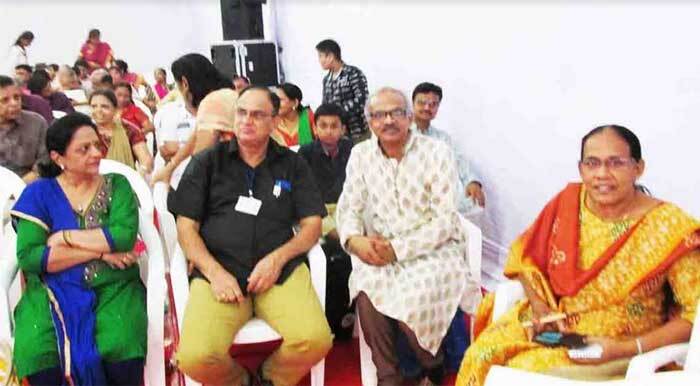
Gujarat Govt Jt Secreary Bhavesh Erda with GSRA vice president Bridget Jose
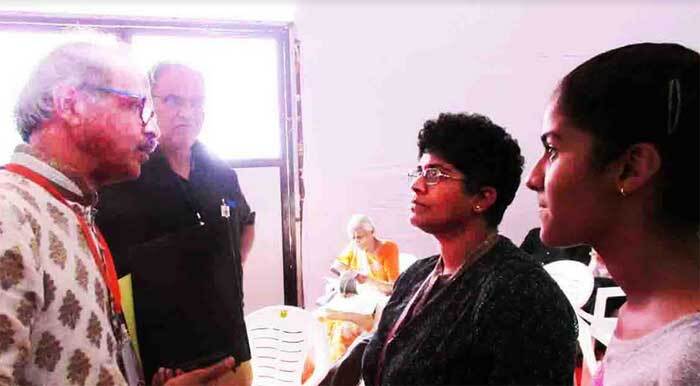
Baroda born archeologist Bina Thomas Tharakan, her daughter Elizabeth in toe, speaks to Bhavesh Erda.

Jt Convener Dhruv Kumar; His grandfather Devshankar M. Pandya, who served as HM of the Gujarati School, behind.
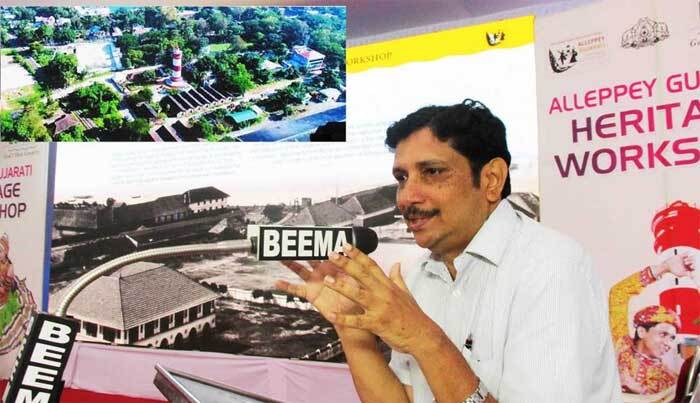
Conservation Architect Benny Kuriakose presents the Alappuzha Heritage Project.
Facebook Comments
Comments
renji 2017-11-21 14:52:38
They will also bring their bigotry, casteism and intlolerance to Kerala: Good Luck.
Leave A Reply
മലയാളത്തില് ടൈപ്പ് ചെയ്യാന് ഇവിടെ ക്ലിക്ക് ചെയ്യുക
അസഭ്യവും നിയമവിരുദ്ധവും അപകീര്ത്തികരവുമായ പരാമര്ശങ്ങള് പാടില്ല. വ്യക്തിപരമായ അധിക്ഷേപങ്ങളും
ഉണ്ടാവരുത്. അവ സൈബര് നിയമപ്രകാരം കുറ്റകരമാണ്. അഭിപ്രായങ്ങള് എഴുതുന്നയാളുടേത് മാത്രമാണ്. ഇ-മലയാളിയുടേതല്ല





